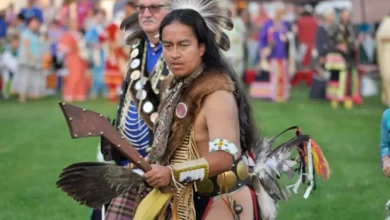The bunad is more than just clothing in Norway; it’s a powerful symbol of national identity, heritage, and pride. Worn during significant events, particularly Norway’s National Day and church rituals, the bunad is a tangible representation of the country’s rich history and regional diversity. This article will explore the fascinating world of the bunad, detailing its significance in these important contexts.
Understanding the Bunad: A Tapestry of Norwegian Culture

What is a Bunad?
At its core, a bunad is a traditional Norwegian costume. However, it’s not just any traditional clothing. The term “bunad” implies a garment with strong historical roots, often associated with a specific geographic area or even a particular family.
The design, materials, and embellishments of a bunad can vary considerably, reflecting the diverse regional identities within Norway. These garments are typically made of wool, linen, or cotton, and are adorned with intricate embroidery, silver fastenings, and other embellishments.
Bunad vs. Folk Costume: Clarifying the Terms
It’s important to distinguish between a bunad and a folk costume, also known as folkedrakt. While both are traditional forms of attire, they have key differences. A folk costume is a broader term that encompasses all types of traditional clothing, whereas a bunad is a specific type of folk costume that underwent a revival in the late 19th and early 20th centuries.
See also Rituals of Gratitude: A Global Look at Harvest Festivals
Rituals of Gratitude: A Global Look at Harvest FestivalsThe bunad movement aimed to create standardized, yet diverse, traditional attire that could be worn with pride by all Norwegians. Therefore, not all folk costumes are bunads, but all bunads are folk costumes.
The Regional Variations: A Map of Norwegian Heritage
One of the most fascinating aspects of the bunad is its incredible diversity. Norway is a land of varied landscapes, from coastal communities to mountain villages, and each region has developed its own unique style. Some examples include:
- Hardanger Bunad: Known for its distinctive embroidery and white apron with black detailing, typically from the Hardanger region.
- Telemark Bunad: Often characterized by vibrant colors and intricate embroidery, showcasing the artistry of the Telemark area.
- Nordlandsbunad: Simple yet elegant, reflecting the northern regions of Norway.
- Oslo Bunad: Though Oslo is a capital city, it has its own established bunad with a refined appearance.
These are just a few examples, and many more exist, each telling a unique story about its particular region. Choosing a bunad is often a matter of personal preference, family history, or a connection to a specific geographic area.
The Bunad in National Day Celebrations: A Symbol of Unity and Pride

The 17th of May: Norway’s National Day
Norway’s National Day, celebrated on the 17th of May, is a day of immense national pride and joy. The holiday commemorates the signing of the Norwegian Constitution in 1814. On this day, the streets of Norway come alive with parades, festivities, and, most importantly, the vibrant colors of the bunad. It’s a day when Norwegians from all walks of life, young and old, come together to celebrate their shared heritage.
See also The Scottish Kilt: A Staple in Highland Dancing and Clan Ceremonies
The Scottish Kilt: A Staple in Highland Dancing and Clan CeremoniesBunads as a Visual Spectacle
The sight of thousands of Norwegians dressed in their regional bunads is truly spectacular. It’s a living tapestry of the nation’s history. This is the single largest public display of these traditional garments, and it highlights the importance of the bunad as a unifying symbol.
The diverse styles and colors worn create a visual representation of the rich cultural mosaic that is Norway. From the intricate silver jewelry to the carefully hand-stitched embroidery, each element tells a story and adds to the overall beauty of the display.
The Significance of Wearing the Bunad on the 17th of May
Wearing a bunad on the 17th of May is more than just following a tradition. It’s a way for individuals to publicly express their national identity and cultural pride. It’s a conscious choice to participate in a collective celebration that honors Norway’s history and heritage.
For many, it’s a deeply personal experience, connecting them to their family’s roots and the values of the Norwegian nation. The practice fosters a sense of community and unity as people from diverse backgrounds come together, united by their shared pride in Norway. The bunad thus becomes a visual testament to the collective identity of the nation.
Children and the Bunad: Passing on the Tradition
The tradition of wearing the bunad begins at a young age, with children often receiving their first bunad as gifts for confirmation or other significant life events. This early introduction helps instill a sense of national pride from childhood and perpetuates the tradition for future generations.
The sight of children parading in their miniature bunads is one of the most heartwarming aspects of the National Day celebrations, signifying the continuity of Norway’s cultural heritage. Furthermore, the making and care of the bunad also become a family tradition, with many women involved in crafting and passing them down through generations.
The Bunad in Church Rituals: A Symbol of Respect and Reverence

Bunads and Life Cycle Rituals
Beyond the National Day, the bunad also plays an important role in various church rituals and ceremonies. From baptisms and confirmations to weddings and funerals, the bunad is often worn to mark significant life events within the religious framework of the Church of Norway. This practice underscores the cultural and spiritual weight of the garment, demonstrating how it seamlessly intertwines with personal and religious expressions.
Bunads at Baptisms and Confirmations
In baptisms and confirmations, the bunad serves as a symbol of respect and tradition. Family members often wear their finest bunads to these events to honor the occasion and the individual. For children, the confirmation is a crucial step in their religious journey, and wearing a bunad signifies their transition into adulthood and community membership. The colors and patterns of the bunad often reflect the family’s regional background, adding a layer of personalized heritage to the event.
Bunads at Weddings: A Blend of Tradition and Celebration
Weddings are another occasion where the bunad shines. Many Norwegian couples choose to incorporate the bunad into their wedding attire, either as part of the ceremony itself or during the reception. Brides and grooms might wear traditional regional bunads, showcasing their unique cultural heritage.
Some couples even opt to have their bridal party dress in bunads, adding an extra layer of cultural richness to the celebration. The bunad at a wedding is not just an item of clothing; it’s a declaration of cultural pride, a visible connection to the past, and a promise for the future.
Bunads at Funerals: A Symbol of Respectful Remembrance
The bunad is also worn at funerals, signifying respect and remembrance for the deceased. Wearing a bunad during a funeral ceremony is a way to honor the life of the departed while connecting them to their cultural heritage. For families, it is a way to say goodbye while being rooted in tradition. The muted colors and understated elegance of the bunad make it an appropriate attire for such solemn occasions, while also reinforcing the continuity of family and cultural heritage.
The Making and Care of a Bunad: A Labor of Love

Handcraftsmanship and Attention to Detail
The creation of a bunad is a labor-intensive process that involves considerable skill and time. The garments are typically handcrafted, often using traditional techniques that have been passed down through generations. The fabrics, embroidery, and silver fastenings are carefully chosen to reflect the specific regional variations. A high-quality bunad is an investment, often made by skilled artisans who take great pride in their work. Each stitch and detail speaks to the dedication and passion poured into its creation.
Preserving the Heritage: Care and Maintenance of a Bunad
Given their intricate nature and cultural significance, proper care and maintenance of a bunad are essential. These garments are not just worn but treasured and often passed down through families.
Proper storage, cleaning, and occasional repairs are necessary to preserve the bunad for future generations. Many families have specific instructions and traditions associated with the care of their bunad, adding to the family’s cultural narrative. The care of a bunad is a family tradition as much as the wearing of it.
The Cost and Investment: A Reflection of Value
Due to the intricate handcraftsmanship involved and the use of high-quality materials, bunads are often expensive. The price can vary widely, depending on the complexity of the design, the fabric, and the craftsmanship involved.
The investment, however, is seen as worthwhile due to the cultural and emotional significance of the garment. For many, owning a bunad is not just about having a traditional costume; it’s about having a tangible piece of Norwegian history and identity. It’s a symbol of pride, family connection, and cultural continuity, making the cost a secondary consideration for most Norwegians.
Conclusion: The Enduring Legacy of the Bunad
The bunad is more than just a traditional costume in Norway; it is a powerful symbol of national identity, heritage, and regional diversity. From the grand National Day celebrations to the intimate moments of church rituals, the bunad connects Norwegians to their history, their families, and their sense of community.
The craftsmanship and the care that goes into making a bunad is a testament to the enduring value placed on tradition and cultural pride. This cherished garment will undoubtedly continue to be a fundamental element of Norwegian identity for many years to come, connecting past, present and future generations.




